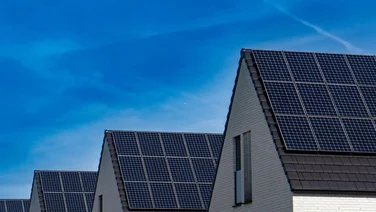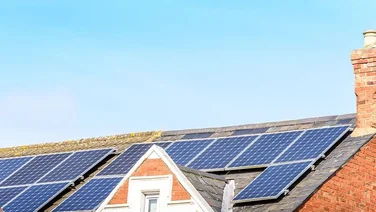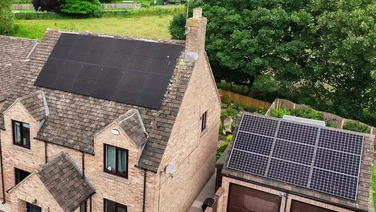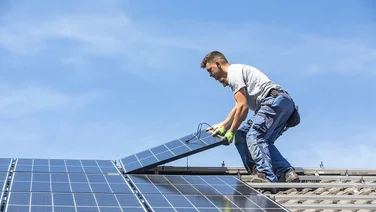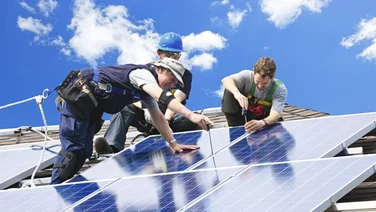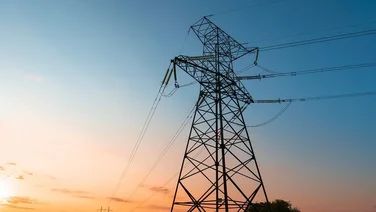✔ DIY solar panel installations cost around £3,000 more than hiring a professional
✔ Installing your own panels can lead to inferior results, or even injury
✔ Fill in the form above for solar panel quotes from trusted specialists
We understand why you want to buy solar panels. They can reduce your monthly energy bills by nearly 50%, the cost of solar panels has fallen by an enormous 70% since 2010, and you’d be helping to fight climate change.
And installing them yourself makes sense too, at first. After all, it must be cheaper, right?
No. In fact, it’s generally more expensive – and it could be dangerous. Just like brain surgery, rhythmic gymnastics, and climbing Everest without oxygen, solar panel installation should only be attempted by experienced professionals who have the best solar panels and expertise to offer.
So if you want trusted experts to provide you with free, bespoke quotes for your solar system, just complete this form.
Where do you want to install solar panels?
Get started
Can you make your own solar panels?
Technically, yes. But if you haven’t been trained in electrical engineering, it’s a long, complicated, expensive process – which could still end with you hiring an expert to do it anyway.
Can you install solar panels yourself?
Yes – but not to the standard you’d ideally want, and probably not to the standard expected by the government for beneficiaries of the Smart Export Guarantee.
Meanwhile, the dangers of setting up your own solar panel system are clear and present.
17% of people who attempt DIY projects cause themselves injuries, according to a MyJobQuote survey – and when you’re high up on a ladder or roof, carrying a cumbersome 40lb solar panel, the risks facing an untrained engineer are too high for comfort.
Step-by-step guide
Assuming you’re completely sure you want to embark on this project, you’ll need to first decide what kind of solar panel system you want. If you’re planning on living off the grid, you’ll need an off-grid system – which makes sense, really.
This requires you to buy a solar charge controller (to prevent overcharging and the current flowing backwards), a battery bank, two DC disconnects, an off-grid inverter, and a backup generator (to guard against power shortages).
Otherwise, your best choice is to set up a grid-tie system, which is the most common kind. This means you’ll still be connected to the national grid, allowing you to draw power from it when needed, and sell your surplus energy during the summer months.
To go down this path, you’ll need a grid-tie solar inverter to convert direct current (DC) to alternating current (AC), micro inverters or a string inverter to power your own home, and a meter to measure how much energy goes to and from the grid.
Next, decide the size and quantity and quantity of solar panels you want (or can afford). You’ll generally need around 12-16 solar panels – which equates to a 3.5 kWh system – to power a three-bedroom house.
Then all you have to do is set up the circuitry. This should ideally be carried out by a trained electrician, or you’ll risk electrocuting yourself and doing damage to your home’s wiring.
Next, you’ll have to carry your panels up a ladder and mount them – an extremely dangerous process which involves hoisting long, 40lb blocks. Imagine lifting a microwave over your head while a dozen metres above the ground, balancing on a ladder.
All that’s left after that is to install the inverter and disconnects.
Even if you’re able to do this all yourself, you’ll still need to ask an electrician to check your work – before getting a Microgeneration Certification Scheme-accredited engineer to do the same – so you can qualify for the Smart Export Guarantee.
And with 69% of people telling our latest National Home Energy Survey that they’re likely or very likely to buy or rent a property with solar panels, we’re sure to see more people attempting to install their own solar panels.
Where do you want to install solar panels?
Get started
The cost of installing your own solar panels
Buying your own materials for a grid-tied system – the type you’ll want, unless you’re abandoning society for a life in the woods – will cost around £10,828.
This is an expensive outlay, especially when you consider that the goods you buy may not be up to scratch if you get them from unreliable sources.
Piece of equipment | Price |
|---|---|
14 solar panels | £7,588 |
14 micro inverters | £2,660 |
Grid-tie solar inverter | £500 |
Meter | £40 |
2 disconnects/circuit breakers | £40 |
It doesn’t help that, as with any technical field, the world of solar power is a difficult area to learn about as you go. This increases the chances of making costly mistakes.
The costs above don’t include your planning permission application, which you may have to pay for – and if your time is money, you should take into account the hours you’ll be spending on research, decision-making, and installing your DIY solar panels.
Pros and cons of DIY solar panels
- Initially cheaper to install – if everything goes perfectly
- You’ll still need an engineer to get your panels certified for the Smart Export Guarantee
- More likely to need repairs and replacement
- Any mistakes can be expensive
- DIY solar panels often won’t last 25 years, and therefore won’t benefit you as much
- The weight, height, and electrical nature of the work makes installation very dangerous
- When incorrectly installed, panels can burn your home down or fall through the roof
- No warranty if you get it wrong
Is making your own solar panel system ever a good idea?
If you’re an electrical engineer, or a specialist in the field of solar energy, and you’re intimately familiar with everything we’ve discussed above, then you may be well-positioned to embark on your DIY solar panel journey.
Otherwise, if you’re simply a homeowner wondering (understandably) if you can save a bit of cash by hooking up your own power supply, you’d be best suited to hire a trusted specialist to do it for you.
After all, the cost of buying the solar system and setting it up is, on average, around £3,000 more expensive if you do it yourself.
“The design and installation of solar PV systems require a high level of skill and expertise. If you try to do it yourself, there’s a high risk you could injure yourself or others, especially if you’re working at height. You could even burn your house down and invalidate your home insurance.”
Chris was a member of the original management team that then developed and launched MCS, and has been heavily involved in MCS ever since as Chair of several technical working groups, as representative of the Solar Trade Association on the Steering Group, and more recently as a Director of the MCS Service Company Ltd.
Solar panel installation: 7 reasons to go professional
1. Significantly cheaper
2. Only way to guarantee quality
3. Much less dangerous
4. You could qualify for the Smart Export Guarantee
5. Less likely to spend £ on repairs and replacements
6. You’ll need a professional to check your work anyway
7. Higher quality equipment
Summary
With a professional installation, you’re likely to get better and cheaper materials, a quicker process, and the peace of mind that comes from knowing your panels are safely attached.
Nothing puts a dampener on your green revolution like 40lb slabs of silicon falling through your roof in the middle of the night.
All these benefits should also make your solar panels cheaper in the long run, as they’ll be more effective and less in need of replacement or repair – and if they do need maintenance, you should have a warranty to fall back on.
If you’d like to receive bespoke quotes from one of these trusted solar specialists, fill in this form.

